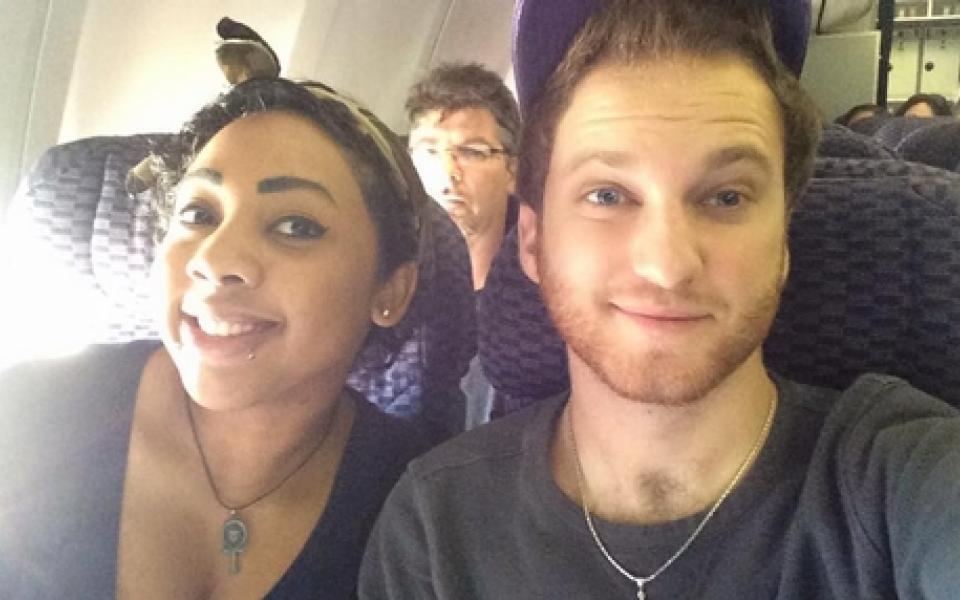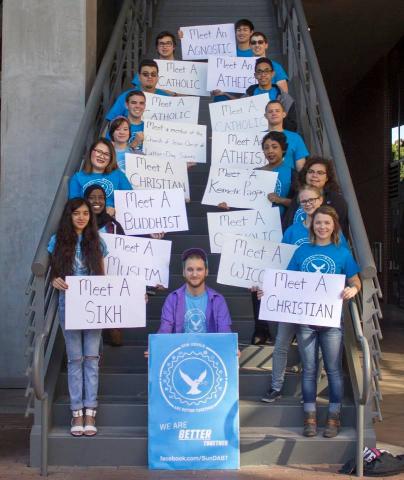
By Johnny Martin
"There are Jews on this plane."
"I know," she responds with a smile.
"So awesome!"
I can hardly contain my excitement. True, most of that excitement is in joyous anticipation of the trip we are about to take to the United Nations headquarters in New York City. But my excitement is overflowing into casual observations with my fellow Cooperation Circle member Aspyn Adam, here in our departure gate at Sky Harbor International Airport in Phoenix, Arizona.
Of course, it's not unusual for Jews to fly on planes. I'm sure there are thousands of Jewish people traveling by airplane every day in the United States. We are one of the most pluralistic countries in the world, after all. There are thousands of Jews, Muslims, Christians, Atheists, Hindus, Buddhists, Sikhs, and more in airports all across the USA on a daily basis as people from different worldviews, backgrounds, and religious or non-religious identities go about their daily lives. In fact, most of the times I've flown with Jewish people in the past, I probably didn't even know it!
But the Jewish men Aspyn and I can see boarding with us are distinct in their appearance. With long, seemingly untrimmed beards, modest attire, and the traditional kippa or yarmulke on each of their heads: they are clearly Orthodox Jews.
As a Religious Studies major at Arizona State University and an interfaith activist in the community, I find any expression of religious or non-religious identity to be completely fascinating and compelling. I'm greatly inspired by the way these men wear their faith so proudly, and I find a certain strength in them doing so publicly in a place where the majority of people present aren't Jewish. It's not unlike the feeling I get when I see a Hijabi (a Muslim woman who wears a headscarf) at the airport or a group of Muslim sisters out in public.
And sure, it might be more difficult for Hijabis than it is for Jewish men to show their faith publicly at airports in the United States (it seems to me that public life for women, in general, is often much harder than it is for men, unfortunately). Still, there's something about the visible expression of religious identity that makes me feel empowered and encouraged, even when it's from a faith tradition other than my own.
I can feel the brim of my own religious headwear pressing lightly around my temples and the top of my skull. At a glance, I'm sure it appears to most people to be nothing more than a regular baseball cap--although perhaps it does seem uniquely colorful with a bright blue cap and purple visor. If someone with a keen eye and a certain level of cultural awareness looks closely enough, however, they might notice the symbol of the crescent star on the front of the cap or the word "alhamdulillah" (meaning "Praise to God") printed on the back.
You think I might feel more cautious or hesitant to wear this symbol of my faith at an airport in Phoenix, Arizona, but I'm well aware of my white American privilege, too. Because I'm a native English speaker of Caucasian-European descent, people rarely (if ever) assume that I'm a Muslim. But when the questions arise, as they sometimes do from my hat or Allah" necklace, I am comfortable answering them.
And I love those questions. They almost always lead to wonderful conversations. I love engaging across lines of difference and discussing shared values with my brothers and sisters in humanity.
I look at my friend Aspyn sitting next to me. She and I are the Vice President and President, respectively, of Sun Devils Are Better Together (or "SunDABT"), the interfaith student organization at Arizona State University. She's wearing an Ankh necklace, an expression of her faith as a Kemetic Pagan. I smile in amusement at a thought which has crossed my mind many times since we began serving our term together as the leaders of SunDABT: In terms of our identities, we're about as different from each other as two people could ever possibly be.
Aspyn is a Pagan, with her core belief being the existence of many gods and goddesses. As a Muslim, my core belief is submission to the One, eternal God and Creator of all existence. She's half Black and half Native American. I have pale skin with Irish, German, and Polish ancestry. She's a beautiful, radical-looking woman with many piercings and a variety of intricate Pagan tattoos covering her body. I'm sort of an average-looking guy with a blue hat and a reddish beard.
And yet, Aspyn and I are like two peas in a pod! Not only do we make an amazing team as Prez and VP, but we've also become extremely close friends. I confide in Aspyn about experiences and thoughts of mine that most people I know aren't privy to. She updates me on her love life, her family, and the plethora of events and activities she's involved with. We relate to each other on so many levels that our relationship literally defines the "Better Together" part of our group's name.
It's a testament to the power of the interfaith movement that people like Aspyn and I can become such great friends. The relationship-building opportunities provided by organizations like Sun Devils Are Better Together can bring people together in extremely profound and impactful ways. Another organization that provides this platform on a much larger scale is the global United Religions Initiative (URI), which is sponsoring Aspyn and me to visit the United Nations on this trip for a celebration of World Interfaith Harmony Week. URI has over 750 member organizations called "Cooperation Circles" (or "CCs") in 92 countries around the world. SunDABT is a CC at Arizona State University, and Aspyn and I feel extremely honored and blessed to have this opportunity to meet other CC leaders at the United Nations.
As our flight takes off for New York City, we're seated several rows behind the Jewish men. I'm disappointed that we won't have a chance to engage them in conversation during our 4-hour flight from Phoenix to Manhattan. But a few moments later, however, I notice a man in collar sitting directly across from us. The collar suggests that he is an ordained clergyperson from one of the many denominations of Christianity. I'm hoping that I'll have a chance to strike up a dialogue with him at some point during our flight, inshAllah (or "God-willing" as we often say in Islam). But even if I don't, I know we'll have many more opportunities to engage across lines of difference during this wonderful interfaith trip to the United Nations with URI.
To read blog posts from other trip participants, click here.

